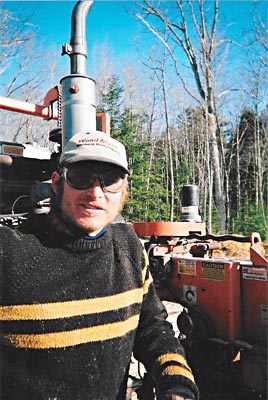 |
| Nick Zandstra |
By Nick Zandstra
One of the underlying premises of MOFGA, I think, is relationships: apprentices with mentors, interest groups with politicians, people with their food, people with the state of Maine. Relationships of all sorts that bring people together, that form connections, that create community.
When MOFGA purchased its site in 1996, the land included a woodlot consisting mostly of abandoned pasture land that had never been managed as a forest and was mostly a monoculture of pine trees lacking quality. A small group of people recognized an opportunity to connect people, animal, plants and the land. The Low-Impact Forest Project (LIF) was formed.
Historically, most farmers also did woods work. Currently, many farms still have woodlots as part of their working landscape, and many landowners have small tracts of woods on their parcels. That small group of LIF people wanted to bring MOFGA’s beautiful but neglected woodlot into the working landscape of MOFGA’s grounds. So began our relationship.
First we got to know those woods. We brought in foresters to analyze the site and create plans. Then we began using the forest as a place to teach people about working in the woods with draft horses. While students learned to relate to horses, we all were learning to relate to the land. We started pruning trees to increase quality. We started to mill inferior wood, which would otherwise go for pulp, into boards to build structures on MOFGA’s grounds. Fences, outhouses, horse stalls and barns were built from wood grown just a quarter mile away. Our relationship began to deepen.
A crucial element of any good relationship is listening, and a relationship with a woodland is no different. The forest told us it needed more work, so we began more serious harvests. When MOFGA acquired more land, we began to engage new woodlots. We removed a lot of inferior trees, sold some logs, and provided firewood to heat MOFGA’s on-site farmer-in-residence house. The woodlot began to look more diverse. Young trees began to grow. Trees such as oak, previously scarce in the pine woods, emerged. We planted special trees, such as American chestnuts, in areas that had been opened enough to provide light to support them.
Lately the forest has been telling us to slow down. We’ve ended the midwinter harvests and have begun to look at offsite locations for some workshops so that we can encourage LIF relationships among even more people.
We’ve been working with the MOFGA woods for 17 years. That may seem like a long time, but some trees in that relatively young forest are as old as our oldest participants. Relationships with woods run deep, and they run long if you let them.
Why does MOFGA have a forestry program? Because good forestry is about relationships, particularly relationships between people and working lands. We in LIF love the woods like we love each other and our horses – that is, we have a fully developed relationship with miscommunications, love, apologies, errors, commitment and forgiveness. Low-impact forestry isn’t just about how to log, any more than MOFGA is just about how to grow a carrot. The relationships are the thing. That’s why we do what we do.
The jingle of the harness, the roar of a chainsaw, the crash of a great tree, the hum of a loader, the stamping of hooves, the whir of a power winch, the chopping of an axe, and deep, intimate relationships born of respect, love and mutual benefit: This is what LIF is.

